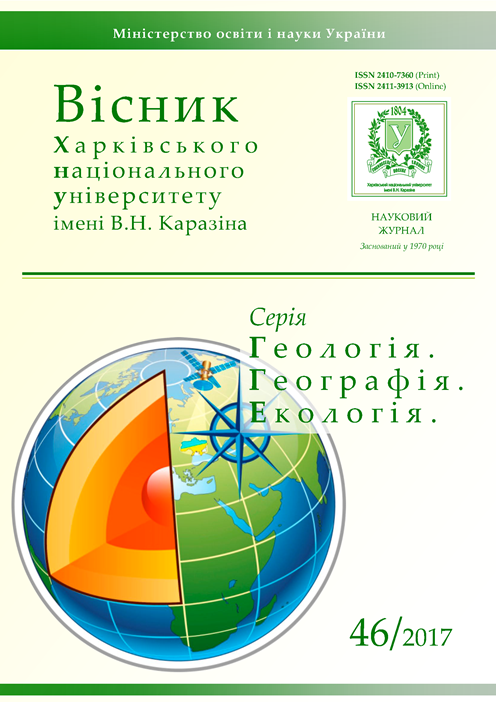Biocentric–networking landscape configuration of left-bank Ukraine
Abstract
The aim of the research is to determine the biocentric-networking landscape configuration (BNLK) contemporary structure as an important basis for the landscape planning tools implementation in the region, according to the results of analysis the factors of its formation and development, and structural-morphometric estimation.
The method is based on the results of our mapping modelling of landscape-typological structure of the Left-Bank Dnipro of the Ukraine territory (at the level of landscape types) and the nature reserve fund. The region of the exploration is the Left-Bank of the Dnipro river which is understood as a totality of four administration regions of Ukraine, such as Poltava, Sumy, Kharkiv and Chernigiv. The BNLK contemporary structure was determined by using GIS-parcel MapInfo Professional 10.0.1, and landscape complexes data, including 1 552 objects of nature reserved fund (by 1.11.2016).
The BNLK is understood as a totality of biocenters, biocorridors, interactive elements, buffer zones and “matrix”, which all together make a special system that supports the ecological equilibrium in a region.
Thus, for the first time in the region all sorts of BNLK elements were differentiated according to the estimated level of forestation, nature reserve fund and landscape-typological structure. Also, we distinguished 88 biocenters and 51 biocoridors,that present different spatial-hierarchical levels, the mapping model of which also was done. All together, in the Left-Bank Dnipro river of Ukraine territory were determined 12 – national, 12 – regional, and 64 – local biocenters; also 4 – national, 5 – regional, and 41 – local (including 16 – at the ²-t level and 25 – at the ²²-nd level) biocoridors. The results received in a such way could be a good background for choosing distinguishing criteria of landscape planning typological units and for future use in landscape planning.
Downloads
References
lessonn_plan/ekomereja.doc.
2. Варивода Є.О. Конструктивно-географічні основи управління природно-заповідним фондом в межах адміністративних районів [Текст]: автореф. дис. ... канд. геогр. наук / Є.О. Варивода. – Харк. нац. ун-т ім. В.Н. Каразіна. – Х., 2009. – 20 с.
3. Гродзинський, М.Д. Основи ландшафтної екології [Текст]: Підручник / М.Д. Гродзинський. – К.: Либідь, 1993. – 224 с.
4. Гродзинський, М.Д. Пізнання ландшафту: місце і простір [Текст]. Монографія. У 2-х томах / М.Д. Гродзинський. – К.: “ВПЦ «Київський університет»”, 2005. – Том І. – 431 с.; Том 2. – 503 с.
5. Десюк, В.С. Картографування та аналіз біоцентрично-мережевої конфігурації (на прикладі Лубенського району Полтавської області) [Текст] / В.С. Десюк, Д.В. Свідзінська // Часопис картографії: Зб. наук. праць. – 2014. – Вип. 10. – 390 с. – С. 179-185.
6. Домаранський А.О. Ландшафтне різноманіття: сутність, значення, метризація, збереження [Текст] / А.О. Домаранський. – Кіровоград: ТОВ “ІМЕКС-ЛТД”, 2006. – 146 с.
7. Максименко Н.В. Ландшафтне підґрунтя перспектив розвитку регіональної і локальної екологічної мережі Харківської області [Текст] / Н.В. Максименко, Р.О. Квартенко // Вісник ХНУ імені В.Н. Каразіна. – №1070. – Серія “Екологія”, Вип. 9. – 2013. – С. 63-73.
8. Петин А.Н. Основы экологии и природопользования [Текст] / А.Н. Петин и др. – М.: Изд-во МГУ, 2004. – 287 с.
9. Разработка концепции экологических коридоров в трансграничных участках бассейна реки Днепр. Финаль-ный отчет [Текст] / Под рук. М.Д. Гродзинского. – К.: КНУ им. Тараса Шевченко, 2002. – 110 с.
10. Розбудова екомережі України [Текст] / За ред. Ю.Р. Шеляг-Сосонка. – К.: Програма розвитку ООН. Проект “Екомережі”, 1999. – 127 с.
11. Самойленко, В.М. Геоінформаційне моделювання екомережі [Текст] / В.М. Самойленко, Н.П. Корогода. – К.: Ніка-Центр, 2006. – 224 с.
12. Самойленко, В.М. Оптимізація вимірювання розрахункових показників при моделюванні басейнової екоме-режі [Текст] / В.М. Самойленко, Н.П. Корогода // Гідрологія, гідрохімія і гідроекологія. – 2009. – Т. 17. – С. 15-26.
13. Самойленко, В.М. Визначення розрахункових показників при моделюванні екомережі в басейнах річок на різ-них територіальних рівнях проектування [Текст] / В.М. Самойленко, Н.П. Корогода // Фізична географія та геоморфологія. – 2010. – № 3 (60). – С. 57-62.
14. Самойленко, В.М. Критерії рівня природно-каркасної значущості та стану об’єктів моделювання екоме-режі в річкових басейнах [Текст] / В.М. Самойленко, Н.П. Корогода // Гідрологія, гідрохімія і гідроекологія. – 2010. – Т. 3 (20). – С. 8-21.
15. Шеляг-Сосонко, Ю.Р. Формування регіональних схем екомережі (методичні рекомендації) [Текст] / Ю.Р. Шеляг-Сосонко. – К.: Фітосоціоцентр, 2004. – 71 с.
16. Шеляг-Сосонко, Ю.Р. Концепция, методы и критерии создания экосети Украины [Текст] / Ю.Р. Шеляг-Сосонко, М.Д. Гродзинский, В.Д. Романенко. – К.: Фитосоциоцентр, 2004. – 144 с.
17. Шищенко, П.Г. Принципы и методы ландшафтного анализа в региональном проектировании. [Текст]: Мо-нография / П.Г. Шищенко. – К.: Фитосоциоцентр, 1999. – 284 с.
18. Angelstam P. Measurement, Collaborative Learning and Research for Sustainable Use of Ecosystem Services [Text] / P. Angelstam, M. Grodzynskyi, K. Andersson // Landscape Concepts and Europe as Laboratory, AMBIO. – 2013. – Vol. 42. – P. 129-145.
19. Forman R.T. Landscape Ecology [Text] / R.T. Forman, M. Gordon. – New York, 1986. – 619 p.
20. McGarigal, K., Marks, B.J. FRAGSTATS: Spatial pattern analysis program for quantifying landscape structure. Version 2.0. Corvallis, 1994. Aviable at: https://www.umass.edu/landeco/pubs/mcgarigal.marks.1995.pdf.





